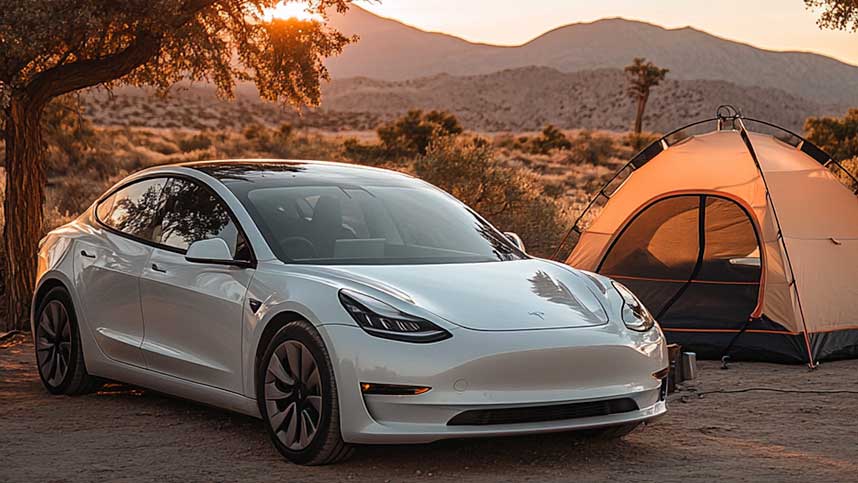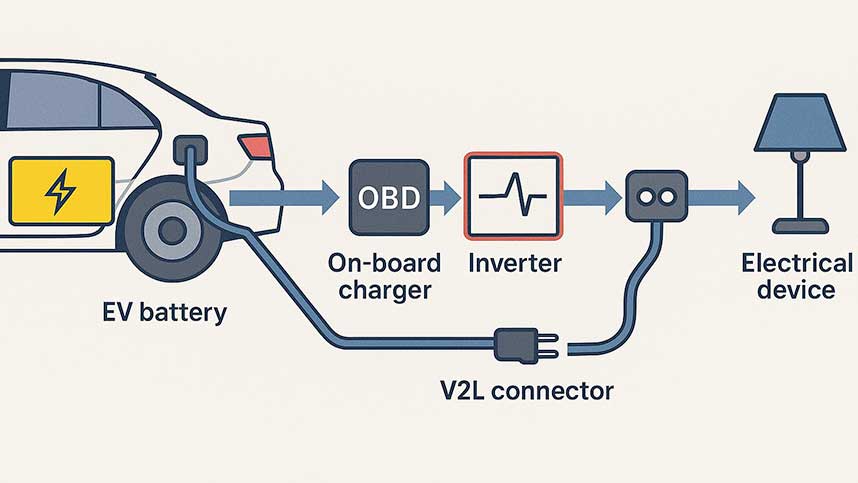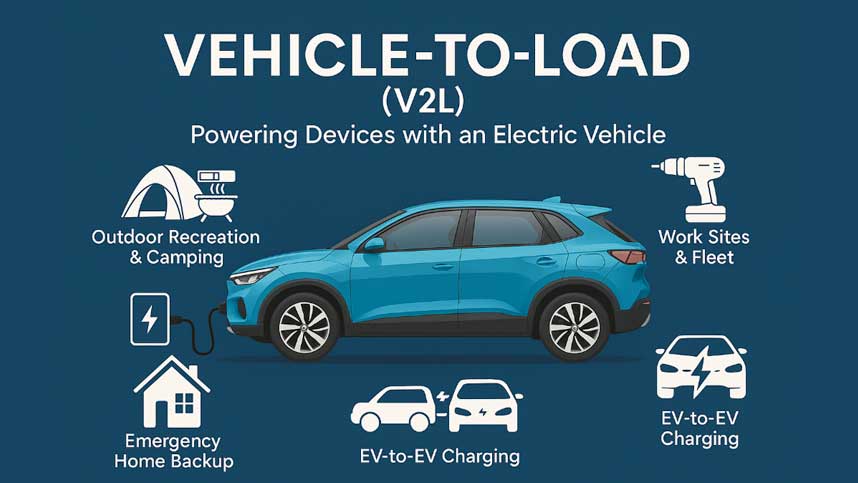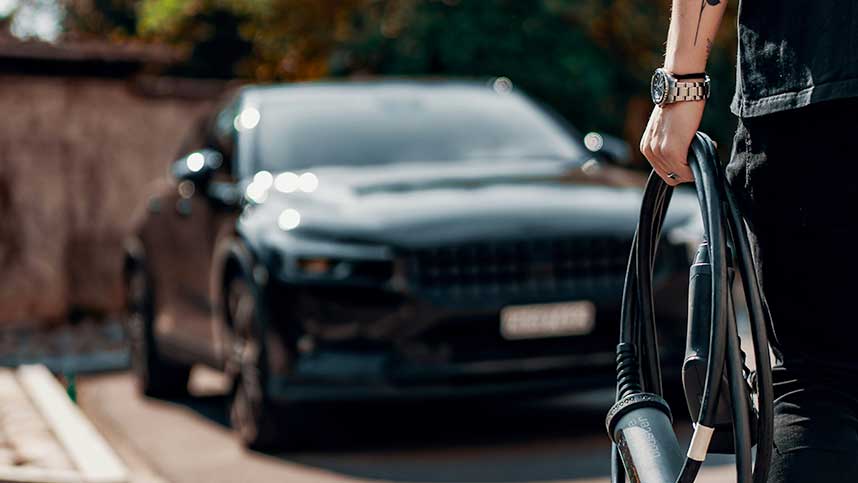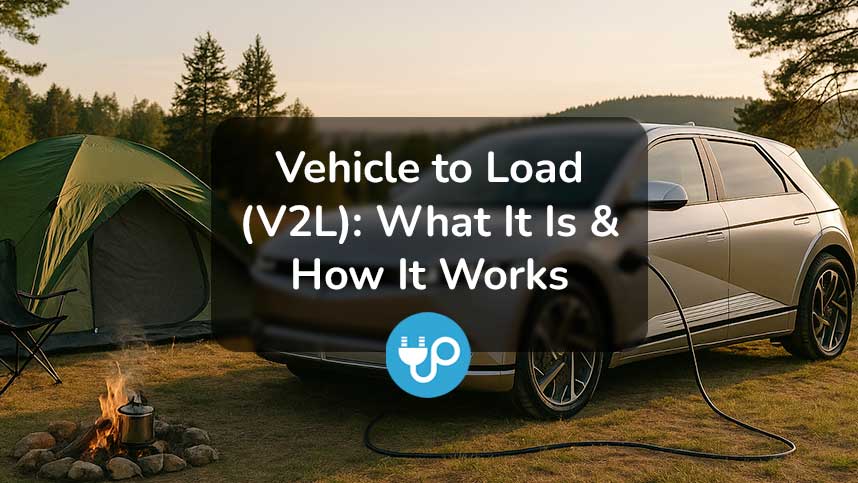
Vehicle to Load (V2L): What It Is & How It Works
Electric vehicles (EVs) are transforming not only how we drive, but also how we use energy in our daily lives.
One innovative feature gaining attention is Vehicle to Load (V2L) – essentially using an EV as a portable power source.
Imagine being able to run a refrigerator during a power cut or brew coffee at a campsite, all from your car’s EV battery.
This article explores what V2L is, how it works, and why it’s useful.
We’ll look at everyday consumer applications (like camping and home backup) as well as industrial and fleet uses (such as powering tools on a job site).
Chapters
What is Vehicle to Load (V2L)?
Vehicle to Load (V2L) refers to an EV’s ability to supply power outward to standard electrical loads.
In simple terms, V2L turns your electric car into a mobile generator or giant power bank.
Instead of using the battery only for driving, V2L lets you tap into that stored energy to run appliances, gadgets, or even charge other vehicles.
This means an EV equipped with V2L can power devices like lights, laptops, refrigerators, basically anything that can plug into a household outlet.
Crucially, Vehicle to Load does this without requiring complex equipment or feeding power back into the grid.
It’s a relatively straightforward technology that uses the car’s onboard systems to provide standard AC electricity, so you can plug in devices just as you would at home.
It’s important to note that V2L is different from Vehicle to Home (V2H) or Vehicle to Grid (V2G).
Those latter technologies send power from the car into a home’s electrical system or the utility grid and usually need special bi-directional chargers or infrastructure.
V2L, on the other hand, is much simpler: it’s more like using your car as a stand-alone generator for appliances, with no complex installation
How Does Vehicle to Load Work?
At the heart of V2L is the EV’s battery and power electronics.
An electric car stores energy as direct current (DC) in its high-voltage battery pack.
To use that energy for most appliances (which run on alternating current, AC), the car uses an onboard inverter/converter to change DC power from the battery into AC power at the appropriate voltage and frequency.
Basically, the same inverter that normally helps charge the battery (by converting AC from the grid to DC for storage) can work in reverse – delivering AC power out from the battery.
This is all managed by the vehicle’s software and power management systems to ensure it’s done safely and within limits.
To actually access the power, V2L-enabled cars provide either a built-in outlet or a special adapter:
Built-in Outlets
Some EVs have standard power sockets installed from the factory.
In a V2L-capable car like the Kia EV6, you might find a regular three-pin 240V socket under the rear seats or in the cargo area.
The Ford F-150 Lightning offers multiple outlets (both 120V and 240V in North America) mounted in the cabin and truck bed.
Vehicle to Load Adapter
Other vehicles use an adapter that plugs into the charging port of the car to provide an outlet.
This adapter essentially turns the car’s charging inlet into a power outlet.
The adapter itself isn’t a transformer, all the voltage conversion and control happen inside the car’s electronics, it simply provides a safe interface for plugging in your appliance.
Typically, you would connect your device or an extension lead to the adapter first, then plug the adapter into the car’s charge port, and activate V2L mode via the car’s settings or a button on the adapter.
Some adapters even have a switch to turn the output on or off for convenience.
Vehicle to Load Safety
Once everything is plugged in and activated, the car will supply power to the device.
No special driving mode is required as usually the EV can be in ‘accessory’ mode or even completely off (with just the V2L system active) while it delivers power.
The EV’s battery management will ensure the battery isn’t drained beyond a certain point – for example, many systems will automatically shut off V2L if the car’s battery drops to around 20%.
Also, as a safety measure, the car will not allow driving while using V2L.
It essentially isolates the drivetrain when in V2L mode so you can’t accidentally drive off with a toaster still plugged in.
In fact, on some vehicles the external charging port lid must be open to use V2L, which by design prevents the car from shifting into drive.
Vehicle to Load Uses
One of the most exciting aspects of V2L is the sheer variety of use cases it opens up.
Whether you’re an everyday consumer or a professional with a fleet, having a self-contained power source in your vehicle can be a game-changer.
Here are some of the key ways V2L is being used:
Outdoor Recreation and Camping
V2L turns an EV into the ultimate camping companion.
You can take electric power into the wilderness, running campsite lights, electric grills, mini fridges, or even a portable projector for an outdoor movie night, all from your car.
Remote camping trips become far more comfortable when you can plug in a kettle for your morning brew or an electric heater for a chilly evening.
Because it’s clean and silent, it won’t disturb the tranquillity of nature like a petrol generator might.
EV owners have reported using V2L to make coffee, cook eggs on an electric griddle, or inflate an air mattress while off-grid.
An electric SUV can run a big screen TV, speakers, or a slow cooker for your party, literally anywhere you park.
Emergency Home Backup
Perhaps one of the most valuable uses of V2L is as an emergency power source during outages.
If your home loses electricity due to a storm or grid failure, an EV with V2L can keep essential devices running.
This might include your fridge and freezer, charging phones and laptops to stay connected, powering some lights, or even running a space heater or fan for comfort.
While a single car likely can’t run an entire house at full power, it can certainly cover critical needs.
EV owners have also used V2L to keep medical devices running during blackouts, to power Wi-Fi routers and communication devices in emergencies, and even to run home gas boilers by providing electricity to the controls and pumps.
Essentially, your EV becomes a reliable backup generator when you need it most.
Work Sites
V2L isn’t just for leisure – it has serious implications for work and industry.
At construction sites, food trucks, or any job location without nearby electricity, an EV with V2L can power tools and equipment.
Contractors can plug in electric saws, drills, compressors, or even heavy-duty gear like cement mixers on-site.
Ford’s system, called Pro Power Onboard, is designed for this very purpose and acts like a built-in power supply for nearly every imaginable tool.
Users have reported running electric jackhammers and water pumps directly from the vehicle when no other power source was available.
Fleet managers are also interested in using V2L-equipped electric vans and trucks as power units for events, maintenance work, and mobile support.
Smaller EVs can be useful to tradespeople needing to power handheld tools or run a printer or glue gun at a client’s site.
Beyond traditional jobs, think of disaster response, an electric vehicle could act as a mobile energy hub, powering emergency equipment or charging devices for first responders.
The possibilities for industrial and fleet use are just beginning to emerge and could offer major advantages in flexibility and efficiency.
EV-to-EV Charging
Another clever use of V2L is to rescue other electric vehicles.
If you find a stranded EV with no remaining charge, a V2L-capable car can provide a ‘jump charge’.
By plugging a standard portable EV charger into the V2L socket, you can deliver a few kilowatt-hours to another EV, enough to get it to a proper charging station.
While this isn’t a fast process, it can be a lifesaver in a pinch.
In the future, roadside assistance services may use V2L-equipped EVs to offer emergency charging in place of towing.
What are the Benefits of Vehicle to Load?
Vehicle to Load brings several compelling benefits for EV owners and society at large.
Here are some of the key advantages:
Convenience and Versatility
With V2L, your car’s energy isn’t locked up for driving only, it becomes available for any electrical need.
This versatility means your EV serves multiple purposes: daily transport, a backup generator, and a portable power supply.
Need to trim the hedges with an electric trimmer but no outdoor socket?
Plug it into the car.
Hosting a picnic in the park and want music and chilled drinks?
V2L has you covered.
Emergency Preparedness and Energy Independence
V2L gives EV owners a measure of energy independence.
During power outages or natural disasters, an EV with a decent charge becomes a lifeline.
It can keep essential appliances and devices running, providing peace of mind.
In areas prone to hurricanes, wildfires, or grid outages, this is a huge benefit.
Even beyond emergencies, having the ability to use your own stored energy can reduce dependence on the grid.
For instance, you could run your home office from the car during a planned outage or off-grid cabin trips.
Replaces Small Generators
Traditionally, people have used petrol or diesel portable generators for remote power or backup.
An EV with Vehicle to Load can replace many of those scenarios with zero emissions and low noise.
This is a big win for both the environment and human health – no fumes, no carbon monoxide risk, no noise pollution.
Camping becomes more enjoyable without the constant roar of a generator.
Likewise, on a job site or at an outdoor event, using vehicle power avoids burning fuel on location.
EV batteries can store far more energy than a small generator’s fuel tank, making them ideal for powering devices over longer periods.
If charged using renewable energy, V2L also provides a greener, more efficient alternative to conventional power sources.
Cost Savings and Efficiency for Work
For businesses or tradespeople, V2L can save money and reduce hassle.
There’s no need to buy, fuel, and maintain a separate generator – the vehicle does the job.
This means less equipment to carry, lower maintenance, and fewer fuel costs.
An EV is often cheaper to run (per kilowatt-hour) than running a generator on petrol.
Over time, these savings can add up significantly.
What are the Drawbacks of Vehicle to Load?
While Vehicle to Load is an exciting feature, it does come with some limitations and downsides that are important to consider:
Limited Power Output and Scope
Even though 2 – 3.6 kW is enough for many devices, it’s still relatively limited compared to the total power consumption of an average household or the needs of some industrial equipment.
You can’t run every appliance at once.
High-wattage items like central air conditioners, electric ovens, or whole-house heating systems will exceed what V2L can supply.
This means V2L is best suited for select essential loads, not an entire home’s full demand.
Using an EV to power a whole house without proper load management would likely trip the system.
The amount of time you can run devices also depends on the car’s battery size – a smaller battery might only keep things running for a short while.
Duration and capacity are finite, so users have to prioritise what to power and for how long.
Battery Drain and Range Impact
Every kilowatt of power used for Vehicle to Load is energy taken from the car’s battery, which reduces the driving range available.
Using V2L extensively when you’re away from charging opportunities could potentially leave you with an empty battery when you need to drive.
Owners must plan ahead. If you know you’ll need to power devices, you might want to start with a higher state of charge or be prepared to recharge sooner.
In emergency backup use, there’s also a bit of a trade-off, if you deplete the car’s battery to keep your home appliances running, you might not be able to drive somewhere else until you recharge.
In critical situations like evacuations, one must balance powering the home versus preserving driving range.
Not Yet Universally Available
Not all EVs offer Vehicle to Load capability at present.
It’s mostly found on newer models.
If your car doesn’t have it, you can’t easily add it through aftermarket solutions.
While there are some third-party inverter kits for certain vehicles, they may not be as seamless or safe.
Consumers wanting V2L might have fewer vehicle choices and potentially higher costs.
Often, V2L requires a higher trim level or an additional-cost option when buying the car.
This could mean an extra expense for buyers who want access to this functionality.
Impact on Battery Life Uncertainties
V2L is still relatively new in the market, so its long-term effect on battery health isn’t fully known.
Using V2L regularly means more discharge cycles for the battery.
While EV batteries are built to handle hundreds or even thousands of full cycles, more frequent and deep use could contribute to faster degradation in the long term.
Someone using their EV daily as a worksite generator might see slightly faster capacity loss than someone using V2L occasionally.
This is similar to using a phone or laptop as a mobile hotspot, it’s fine to do, but heavy use over time may affect battery longevity..
Conclusion
You should now have an understanding of what Vehicle to Load is.
Vehicle to Load technology showcases the evolving potential of electric vehicles beyond just driving from A to B.
By enabling cars to act as portable power stations, V2L redefines what we can expect from vehicle ownership
It provides a safety net during power cuts, can save money and hassle in various scenarios, and does so in a clean, quiet manner that underscores the environmental benefits of EVs.
While there are limits to what V2L can do, the advantages it brings are significant.
As more automakers implement this feature and push its capabilities further, V2L is set to become a normal part of the electric vehicle experience.
As we move into the future of electrified transport and energy, Vehicle to Load is poised to play a key role, empowering EV owners to use energy on their own terms, wherever their journey takes them.
For more information, or if you’re thinking of renting our your home EV charger, get in contact with Joosup today.
Blog Archive
- Solid State EV Batteries – A Game Changer?
- What is a CT Clamp and Does My Charger Need One?
- Is Using an EV Granny Charger Safe?
- Charge Rage: Is It Really a Thing?
- Vehicle to Load (V2L): What It Is & How It Works
- 16 Top Charge Point Operators in the UK
- 8 Types of EV Battery Explained
- Where Can I Charge My Electric Car?
- Electric Car Maintenance and Servicing Guide
- How Often Should I Charge My Electric Car?
- How to Check EV Battery Health
- Do Electric Cars Pay Road Tax?
- October 2024 Budget: Key EV News
- EV vs ICE – Which is Best?
- Should I Charge My EV to 80 or 90 or 100%?
- UK Government Announces Hybrid Sales Allowed Until 2035
- BEV vs PHEV – What’s the Difference?
- Definitely Not A Guru (Jim Starling) Reviews Joosup
- How Long Do Electric Car Batteries Last?
- 25 New Electric Car Brands on UK Roads

